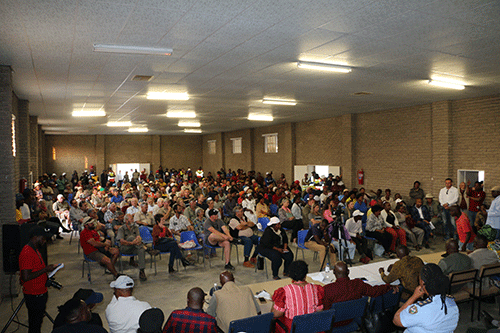LEONARDVILLE – One of the sleepy villages in the Omaheke region, Leonardville, is now experiencing a carnival-like atmosphere after it was discovered that surrounding areas are blessed with coveted uranium deposits. However, environmentalists and some local farmers remain resolute that a proposed uranium extraction method’s risks outweigh the benefits.
This week, the Parliamentary Standing Committee on Economics and Natural Resources visited the exploration activities in the Leonardville area, before meeting with the residents in an effort to stop the ongoing uranium squabble.
At a well-attended gathering on Wednesday, the local community confessed their confusion about the proposed project, simultaneously lamenting the fact that many of them go to bed on empty stomachs.
Thus, many community members pleaded with government to allow the exploration and mining to continue in the area to boost economic activities.
Only a few meeting participants objected to the proposed mining method, fearing contamination of scarce underground water resources.
Leading the charge for the Omaheke Uranium project is Headspring Investments, the Namibian subsidiary of Russian company Uranium One, which in turn is part of the Russian state-owned nuclear energy company Rosatom.
The company’s exploration activities in the area have now been halted for almost a year. Much of the controversy surrounding the project is the proposed extraction method known as in-situ recovery (ISR) or solution mining. ISR is an extraction process used to recover minerals such as copper and uranium through boreholes drilled into a deposit.
Community concerns
Victoria Kauluma, who resides about 60km outside Leonardville, alleged that wealthy farmers in the area are the ones blocking and objecting to the uranium project. She said the actual fear is not about water contamination, but rather that the local workforce will be absorbed by the Russian company, thereby leaving them with no one to exploit.
Leonardville resident Titus Huisemab charged that the ‘white people’ in the area are against the uranium activities because “they are full of greed and selfishness”.
Huisemab, a law student, said “there are so many undercover dealings around the matter. Our community is desperate and confused at the same time because of hunger. I plead with the Agriculture, Water and Land Reform ministry, which is also believed to be against the exploration, to reveal their report on the matter for us to read and digest the information for ourselves”.
Meanwhile, some community members accused the concerned company of “playing mind games” by showering locals with developmental projects.
Also in strong opposition to the uranium project is geologist Roy Miller, who made it clear that this is a no-go area for Namibia. His major concern is that after extensive research, he discovered that groundwater is the only source of drinking water in the Stampriet Artesian Basin (SAB).
“The SAB economy depends almost totally on agriculture, and agriculture is the largest employer in rural areas. If groundwater becomes contaminated, we will be staring at a long-term disaster,” said Miller at the meeting.
He added that in-situ leaching creates numerous problems, as the method releases high-grade uranium into the water, as well as radioactive decay products which dissolve heavy metals, thereby releasing them into the water and adding huge amounts of sulphates.
Miller noted that many problems are underground, where nobody can see them.
Johan Brandt, a commercial farmer in the area, likewise expressed concern about water contamination, noting that the risks far outweigh the benefits.
At the meeting, chairperson of the Leonardville Village Council Petra Witbooi said Uranium One’s operations would open the floodgates for the development of the village. She added that she has no doubt the company will help tackle unemployment and poverty in the village.
However, Witbooi failed to understand why her village is treated like one of the remote areas, receiving no attention from government.
“We feel left out, and it is so disheartening that we do not receive the attention like many other villages. We are not even far from the city centre, but you rarely see government officials in our streets,” she moaned.
Show us evidence
Taken through presentations and a site tour, chairperson of the committee Tjekero Tweya said both sides, for and against the project, should provide evidence to the committee for them to make an informed decision regarding the matter.
“We are here to listen to you, but give us evidence for whatever you are saying. The committee will further do its own research before presenting the report to the National Assembly,” he added.
He further demanded that Uranium One provides its invoices paid to commercial farmers and for the developmental projects they carried out so far.
“Namibia learned a lesson from the past about empty promises from investors. We are interested in socio-economic benefits for our people here,” Tweya stressed.
Mining response
Despite the community’s pushback, Uranium One remained steadfast that the proposed ISL mining method is more economically viable and environmentally- friendly when compared to conventional mining.
The company contends that ISL typically involves extracting the ore mineral from a deposit by injecting a suitable leach solution into the ore zone below the water table, with a minimal disturbance of the existing natural conditions of the earth’s subsurface and surface.
Director of operations at Uranium One Aldo Hengari said while presenting the initial exploration and mining developmental plan that the company already invested about N$850 million.
“We only managed to explore 50% before the halt in 2021. We only drilled 590 boreholes from the eight EPLs we got. Only 14 of the 590 fall under the communal area. From the 50%, we anticipate 25 years of life of mine, which we expect to commence upon completion of the exploration phase,” he detailed.
Hengari further noted that they intend to construct a uranium processing plant, which can process up to 3000 tonnes per year.
He said the uranium project expects annual revenue of N$6.6 billion, while employing about 800 direct employees, if or when mining commences in 2029. –mndjavera@nepc.com.na
Caption:


